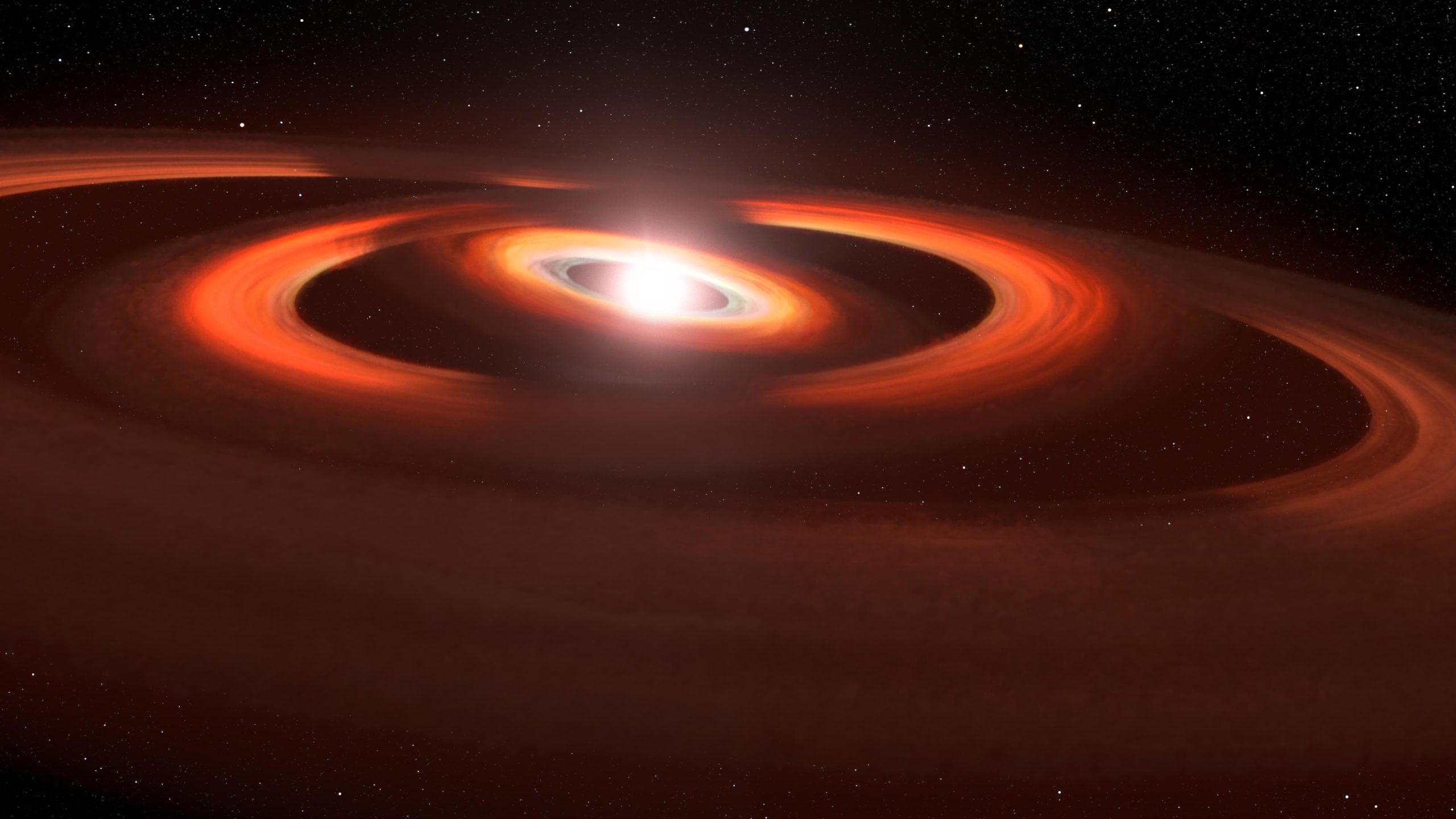このアーティストのコンセプトは、うみへび座TW星の周りのガスと塵の円盤のハッブル宇宙望遠鏡の画像に基づいています。 ハッブル宇宙望遠鏡の画像は、システムを囲むディスクを飲み込む影を示しています。 説明は、これらの影は、星の光が外側の円盤に到達するのを妨げるわずかに傾いた内側の円盤から来ており、こうして影を落としているということです。 目に見えない惑星の重力が円盤構造をゆがめているため、円盤は互いにわずかに傾いています。 クレジット: NASA、Aura/STScI、欧州宇宙機関、Leah Hostack (STScI)
目に見えない生まれたばかりの惑星が若い星の周りにほこりをかき立てる
私たちの世界は非常に気まぐれで、かくれんぼをしたくなることがあります。 2017 年、天文学者たちは、近くの若い星 TW うみへび座を取り囲む塵とガスの円盤を巨大な影が飲み込んでいるのを見て驚いた。 影は、外側の円盤の平面に対してわずかに傾いている内側の塵とガスの円盤によって投じられます。 影がはっきりと見えるのは、このシステムが地球上で向かい合って傾いているためです。天文学者は、影が時計の針のように円盤の周りを飛び回るので、円盤の鳥瞰図を得ることができます。
しかし、この時計には 2 つの針 (時針と分針) があり、異なる速度で動きます。 そして、TW Hydraeもそうであることがわかりました. 天文学者はハッブルを使用して、2 つの外側の円盤に向かって傾いている、別の内側の円盤から出現する 2 番目の影を見つけました。 したがって、システムは、互いにわずかに傾いた少なくとも 3 つの重なり合うディスクで、ますます複雑に見えます。 ディスクは、星の周りの目に見えない惑星のプロキシです。 各惑星は、その重力で星の近くの物質を引き寄せ、惑星がなければ完全に平らなパンケーキ型の円盤を変形させます。 太陽系の惑星は軌道面の傾きが互いに数度異なるため、これは驚くべきことではありません。 うみへび座TW号は、天文学者にリングサイドの席を提供し、私たちの太陽系がその形成期にどのように見えたかを見ることができます。

数年離れたハッブル宇宙望遠鏡からの画像を比較すると、若い星 TW うみへび座を取り囲むガスと塵の円盤を横切って反時計回りに移動する 2 つの不気味な影が明らかになりました。 円盤は地球上で向かい合って傾いているため、天文学者は星の周りで何が起こっているかを俯瞰できます。 左の写真は 2016 年に撮影されたもので、影が 1 つだけ写っています [A] 11時です。 この影は、外側の円盤に対してわずかに傾いている内側の円盤によって投じられ、星の光を遮っています。 左の画像は、介在する別の円盤から現れた 2 番目の影を示しています [C] 午前 7 時、2021 年に撮影。オリジナルのインナー ディスクに刻印あり [B] この後続のショーで。 影は、時計回りなどのさまざまな速度で星の周りを回転します。 これらは、塵を軌道に引き込んだ 2 つの目に見えない惑星の証拠です。 これにより、それらは互いにわずかに傾いています。 これは、宇宙望遠鏡のイメージング分光放射計で撮影された可視光画像です。 ディテールを強調するために合成色が追加されています。 クレジット: NASA、ESA、STScI、John Debes (ESA の AURA/STScI)、Joseph DePasquale (STScI)
ハッブル宇宙望遠鏡は、惑星を形成する円盤の周りの影遊びをたどります
若いスター TW Hydrae は、彼を見守る科学者たちと「影絵人形」を演じています[{” attribute=””>NASA’s Hubble Space Telescope.
In 2017, astronomers reported discovering a shadow sweeping across the face of a vast pancake-shaped gas-and-dust disk surrounding the red dwarf star. The shadow isn’t from a planet, but from an inner disk slightly inclined relative to the much larger outer disk – causing it to cast a shadow. One explanation is that an unseen planet’s gravity is pulling dust and gas into the planet’s inclined orbit.
Now, a second shadow – playing a game of peek-a-boo – has emerged in just a few years between observations stored in Hubble’s MAST archive. This could be from yet another disk nestled inside the system. The two disks are likely evidence of a pair of planets under construction.
TW Hydrae is less than 10 million years old and resides about 200 light-years away. In its infancy, our solar system may have resembled the TW Hydrae system, some 4.6 billion years ago. Because the TW Hydrae system is tilted nearly face-on to our view from Earth, it is an optimum target for getting a bull’s-eye-view of a planetary construction yard.
The second shadow was discovered in observations obtained on June 6, 2021, as part of a multi-year program designed to track the shadows in circumstellar disks. John Debes of AURA/STScI for the European Space Agency at the Space Telescope Science Institute in Baltimore, Maryland, compared the TW Hydrae disk to Hubble observations made several years ago.
“We found out that the shadow had done something completely different,” said Debes, who is principal investigator and lead author of the study published in The Astrophysical Journal. “When I first looked at the data, I thought something had gone wrong with the observation because it wasn’t what I was expecting. I was flummoxed at first, and all my collaborators were like: what is going on? We really had to scratch our heads and it took us a while to actually figure out an explanation.”
The best solution the team came up with is that there are two misaligned disks casting shadows. They were so close to each other in the earlier observation they were missed. Over time they’ve now separated and split into two shadows. “We’ve never really seen this before on a protoplanetary disk. It makes the system much more complex than we originally thought,” he said.
The simplest explanation is that the misaligned disks are likely caused by the gravitational pull of two planets in slightly different orbital planes. Hubble is piecing together a holistic view of the architecture of the system.
The disks may be proxies for planets that are lapping each other as they whirl around the star. It’s sort of like spinning two vinyl phonograph records at slightly different speeds. Sometimes labels will match up but then one gets ahead of the other.
“It does suggest that the two planets have to be fairly close to each other. If one was moving much faster than the other, this would have been noticed in earlier observations. It’s like two race cars that are close to each other, but one slowly overtakes and laps the other,” said Debes.
The suspected planets are located in a region roughly the distance of Jupiter from our Sun. And, the shadows complete one rotation around the star about every 15 years – the orbital period that would be expected at that distance from the star.
Also, these two inner disks are inclined about five to seven degrees relative to the plane of the outer disk. This is comparable to the range of orbital inclinations inside our solar system. “This is right in line with typical solar system style architecture,” said Debes.
The outer disk that the shadows are falling on may extend as far as several times the radius of our solar system’s Kuiper belt. This larger disk has a curious gap at twice Pluto’s average distance from the Sun. This might be evidence for a third planet in the system.
Any inner planets would be difficult to detect because their light would be lost in the glare of the star. Also, dust in the system would dim their reflected light. ESA’s Gaia space observatory may be able to measure a wobble in the star if Jupiter-mass planets are tugging on it, but this would take years given the long orbital periods.
The TW Hydrae data are from Hubble’s Space Telescope Imaging Spectrograph. The James Webb Space Telescope’s infrared vision may also be able to show the shadows in more detail.
Reference: “The Surprising Evolution of the Shadow on the TW Hya Disk” by John Debes, Rebecca Nealon, Richard Alexander, Alycia J. Weinberger, Schuyler Grace Wolff, Dean Hines, Joel Kastner, Hannah Jang-Condell, Christophe Pinte, Peter Plavchan and Laurent Pueyo, 4 May 2023, The Astrophysical Journal.
DOI: 10.3847/1538-4357/acbdf1
The Hubble Space Telescope is a project of international cooperation between NASA and ESA. NASA’s Goddard Space Flight Center in Greenbelt, Maryland, manages the telescope. The Space Telescope Science Institute (STScI) in Baltimore conducts Hubble science operations. STScI is operated for NASA by the Association of Universities for Research in Astronomy, in Washington, D.C.

「音楽マニア。プロの問題解決者。読者。受賞歴のあるテレビ忍者。」



More Stories
JGB Curveは、日本の金融の健康に関する懸念の中で認めています – TradingViewニュース
週末の睡眠を補うことで心臓病のリスクが5分の1減少する可能性がある――研究 |心臓病
化石によると、先史時代のカイギュウはワニとサメに食べられた